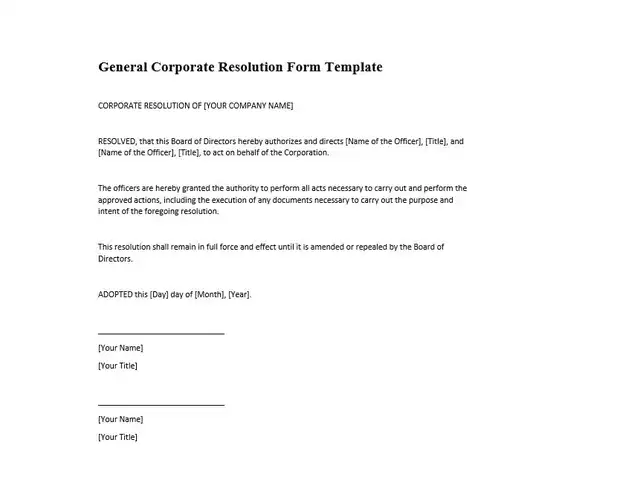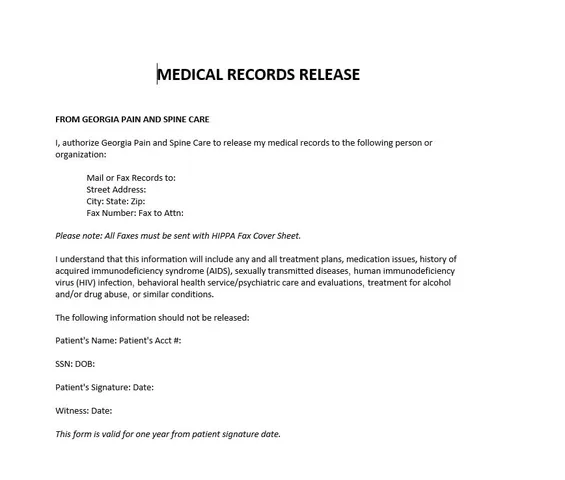Client intake form examples are a tool that helps businesses gather important information from new clients. It is a simple questionnaire that clients fill out. This form collects details that help the business understand the client’s needs and plan the best way to help them.
What is a Client Intake Form?
A client intake form is a questionnaire that clients fill out at the beginning of the intake process. This form helps the business gather important details about the client.
Who Can Use a Client Intake Form?
Many different types of businesses and professionals can use a client intake form. It helps them gather important information about new clients. Here are some examples of who can use a client intake form examples:
Small Business Owners
Small business owners can use client intake forms to understand their customers better. This includes:
- Hair Salons: To know clients’ hair types and preferences.
- Fitness Trainers: To learn about clients’ fitness goals and health conditions.
- Tutors: To understand students’ learning needs and goals.
Healthcare Providers
Doctors, nurses, and other healthcare providers use it. This helps them give the best care. Examples include:
- Doctors: To know patients’ medical history and current health issues.
- Dentists: To understand patients’ dental history and concerns.
- Therapists: To learn about clients’ mental health and therapy goals.
Legal Professionals
Lawyers and legal firms use client intake forms to collect details about their clients’ legal issues. This helps them plan the best way to help. Examples include:
- Lawyers: To gather information about clients’ legal cases.
- Paralegals: To assist lawyers by collecting client details.
Consultants
Business consultants use it to learn about their client’s business challenges and goals. This helps them provide effective solutions. Examples include:
- Business Consultants: To understand clients’ business problems and goals.
- Marketing Consultants: To gather information about clients’ marketing needs and strategies.
Counselors and Therapists
Counselors and therapists use it to understand their clients’ mental health needs. This helps them provide better support. Examples include:
- Counselors: To know clients’ mental health history and therapy goals.
- Therapists: To learn about clients’ current issues and support systems.
Client intake forms are useful tools for many types of professionals.
What is a Client Intake Process?
A client intake process is the series of steps a business takes to gather information from new clients. This helps the business understand what the client needs and how to help them best. It includes:
- Meeting the Client: This can be in person, on the phone, or online.
- Asking Questions: This is where the business learns about the client’s needs and goals.
- Filling Out Forms: The client fills out a form with important details.
- Planning: The business uses the information to plan the best way to help the client.
- Starting the Work: With a clear plan, the business begins working with the client.
What Does a Client Intake Form Include?
A good client intake form should include the following parts:
Personal Information
The form starts with personal information about the client. This helps the business know who they are working with. It usually asks for:
- Name: The client’s full name.
- Contact Details: Phone number, email address, and home address.
- Basic Info: Sometimes, the form may ask for other basic details like age or gender.
Project Details
Next, the form includes project details. This part helps the business understand what the client needs help with and what their goals are. It asks for:
- Description of the Project: What does the client need help with? For example, a new website, legal advice, or a health check-up.
- Goals: What the client hopes to achieve. For example, they are improving their website’s look, solving a legal problem, or getting healthier.
Budget and Timeline
The form also asks about the client’s budget and timeline. This helps the business plan how much time and resources they will need. It includes:
- Budget: How much the client can spend on the project or service.
- Timeline: When the client needs the work done. This could be a specific date or a general time frame, like “within three months.”
Preferences
The form includes a section for the client’s preferences. This part lets the client share any special requests or requirements they have. It can include:
- Specific Needs: Any particular way the client wants things done.
- Special Requests: Any extra services or special considerations the client wants.
Additional Notes
Lastly, the form has a section for additional notes. This is where the client can share any other important information that didn’t fit into the other sections. It might include:
- Extra Details: Any other information the client thinks is important.
- Personal Notes: Anything personal the client wants to share that could help the business understand their needs better.
Why Use a Client Intake Form Examples?
Using a client intake form has many benefits:
- Better Understanding: It helps you learn more about your client’s needs and preferences.
- Clear Communication: It sets clear expectations right from the start.
- Saves Time: You get all the necessary information at once, making the process faster.
- Builds Trust: It shows clients that you are organized and professional.
How to Create a Client Intake Form
Creating client intake form examples is easy. Follow these steps:
- Choose a Template: Start with a basic template.
- Customize the Form: Add your business logo and customize the questions to fit your needs.
- Test the Form: Before using it with real clients, test the form with a few people to make sure it’s clear and easy to fill out.
- Use the Form: Once you’re happy with the form, start using it with new clients.
Tips for Using Client Intake Forms
Here are some tips to make the most out of your client intake forms:
- Keep It Simple: Make sure the form is easy to understand and fill out. Avoid using complicated language or too many questions.
- Be Clear About Why You Need the Information: Let clients know why you are asking for each piece of information and how it will help them.
- Review the Form Regularly: As your business grows, your needs may change. Make sure to update the form regularly to keep it relevant.
- Use Digital Forms: Digital forms are easier to fill out and store. Consider using online tools to create and manage your client intake forms.
Examples of Client Intake Form Questions
To help you create your client intake form, here are some example questions you might include:
- Personal Information:
- What is your full name?
- What is your contact number and email address?
- Project Details:
- Can you describe the project you need help with?
- What are your main goals for this project?
- Budget and Timeline:
- What is your budget for this project?
- When do you need the project completed?
- Preferences:
- Do you have any specific preferences or requirements?
- Additional Notes:
- Is there any other information we should know?
Free Client Intake Form Examples
Salon Client Intake Form Examples
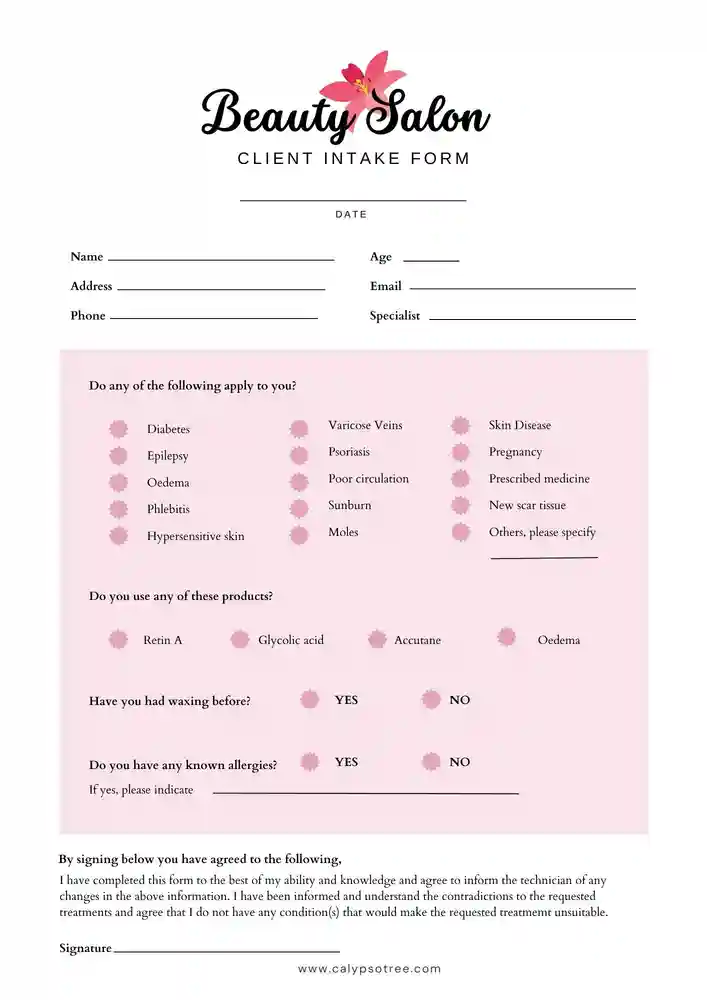
This template gathers details about a client’s hair type, preferences, and any previous treatments. This helps stylists provide personalized services.
Web Design Client Intake Form Examples
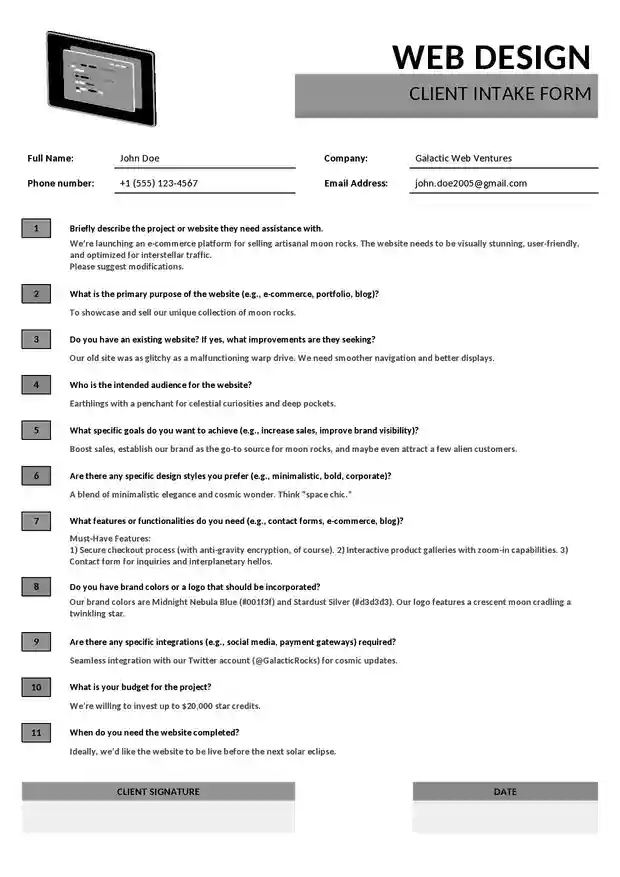
This form collects information about the client’s business, website goals, design choices, and budget. It helps web designers create a site that meets the client’s needs.
Real Estate Client Intake Form Examples
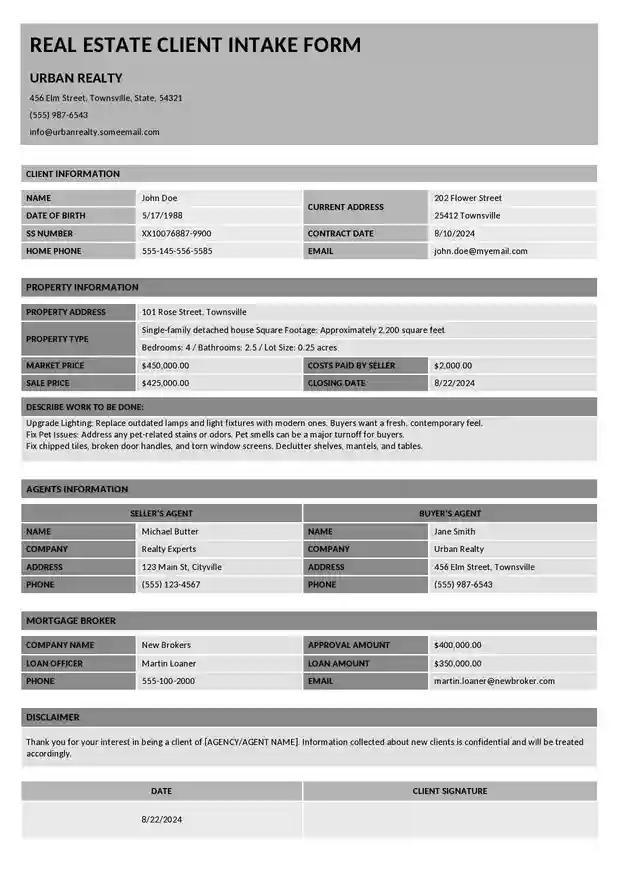
This template gathers details about what clients are looking for in a property, their budget, and preferred locations. This assists real estate agents in finding the best properties for their clients.
Personal Training Client Intake Form Examples
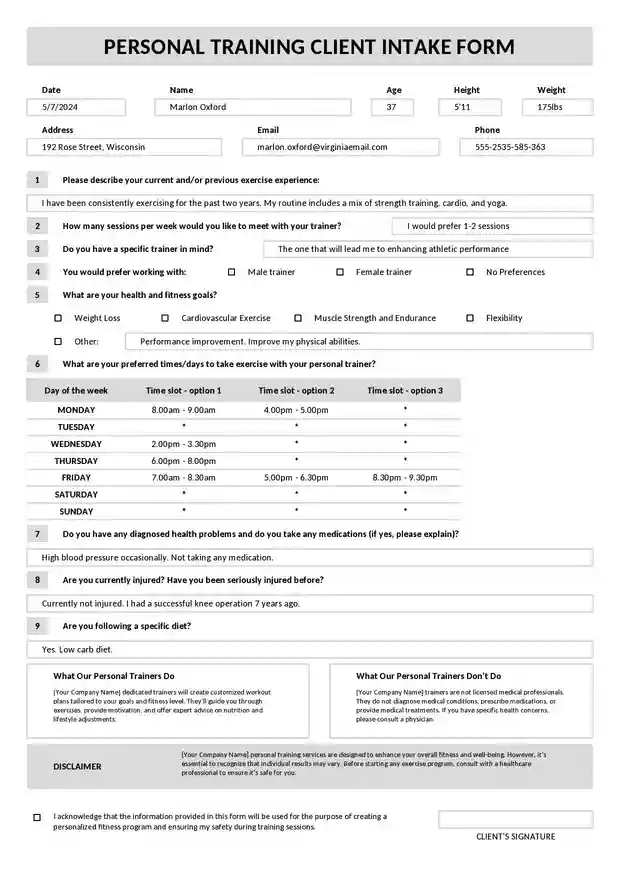
This form collects information about a client’s fitness goals, health history, and exercise preferences. This helps trainers create effective workout plans.
Coaching Client Intake Form Examples
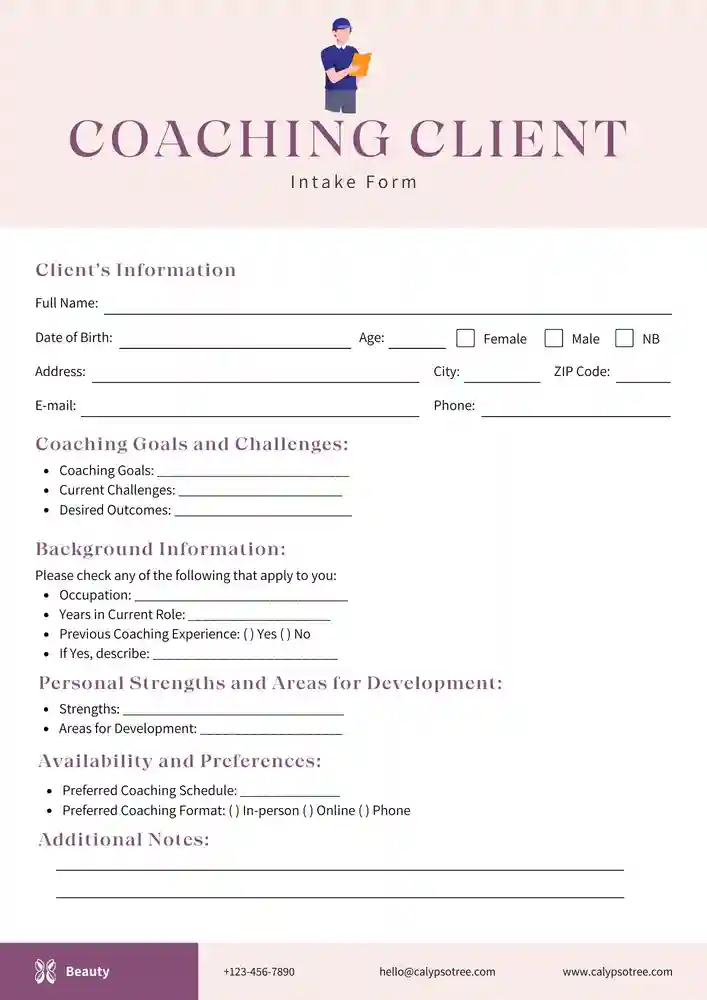
This template gathers details about a client’s goals, challenges, and what they hope to achieve through coaching. This helps coaches provide the right support.
Interior Design Client Intake Form Examples
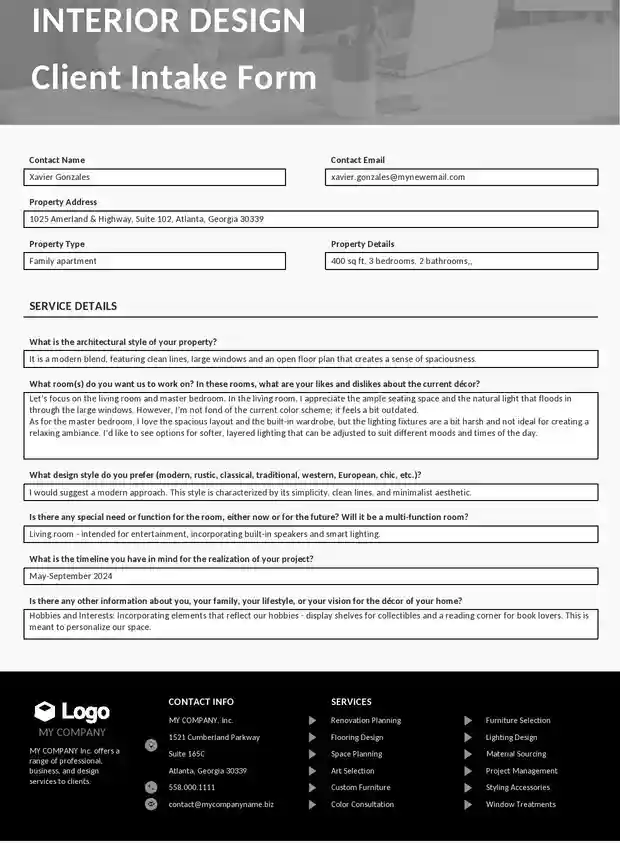
This template gathers details about a client’s style preferences, budget, and the spaces they want to redesign. This helps designers create personalized plans.
Esthetician Client Template
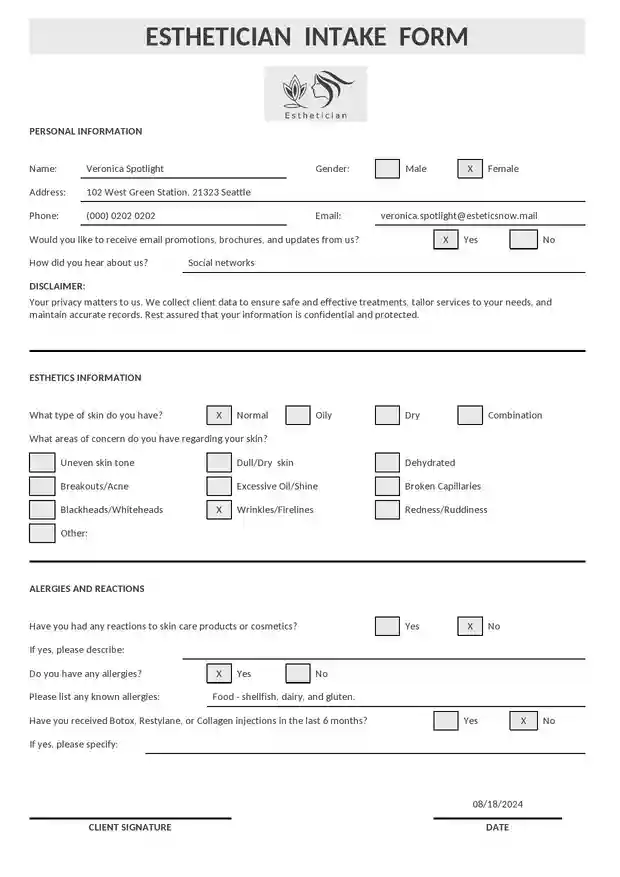
This template gathers details about a client’s skin type, concerns, and any previous treatments. This helps estheticians create personalized skincare plans.
New Client Form Examples
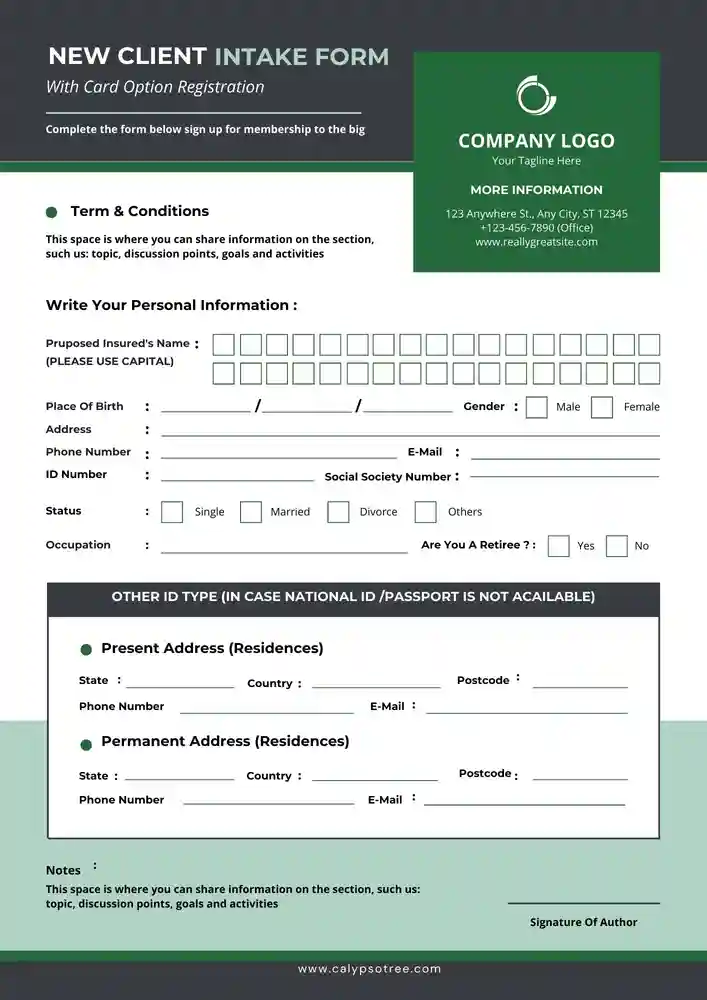
This is a general form that gathers basic information about new clients. Different types of businesses can use it to understand client needs better.
Massage Therapy Intake Form Examples
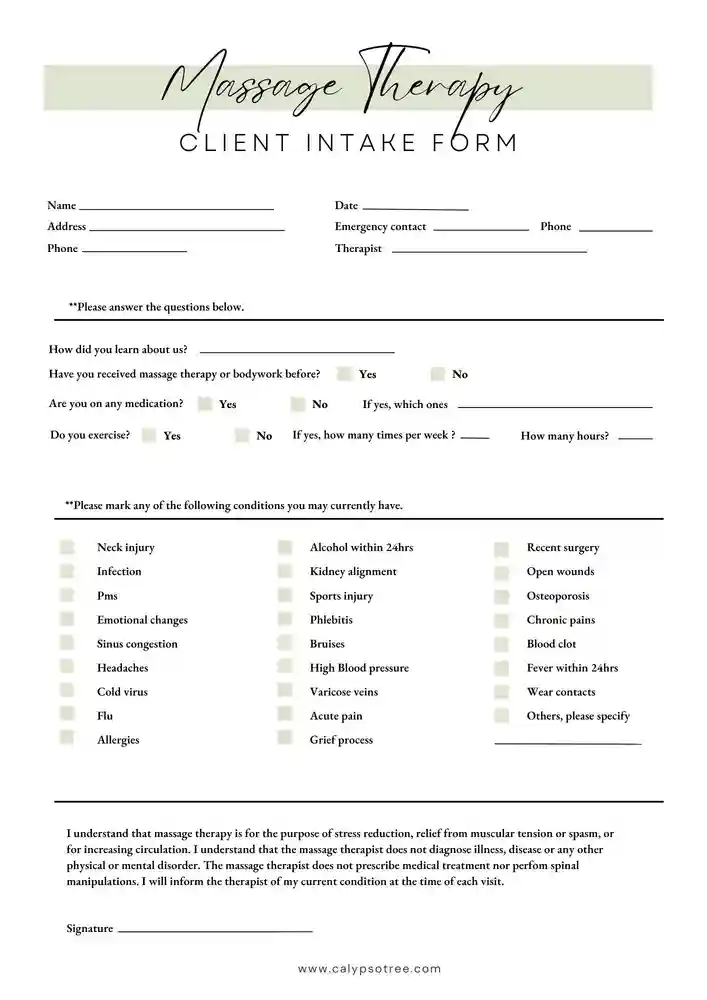
This form collects information about a client’s health, massage preferences, and any specific areas of concern. This helps massage therapists provide effective treatments.
Travel Client Intake Form Examples
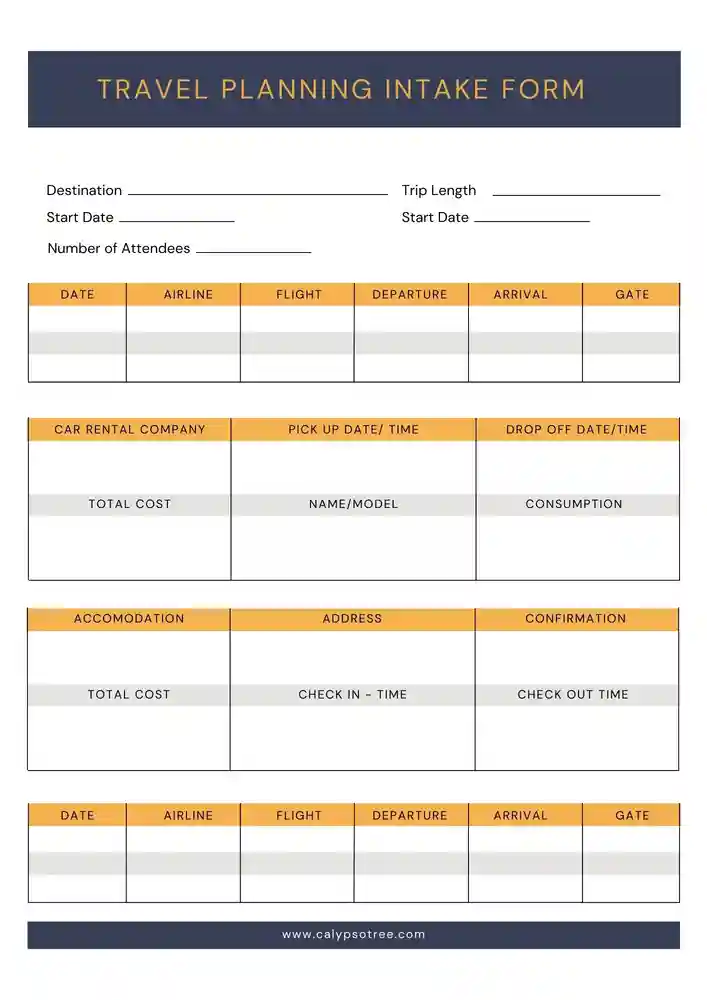
This form collects details about a client’s travel preferences, budget, and desired destinations. This helps travel agents plan perfect trips for their clients.
Law Firm Client Form Example
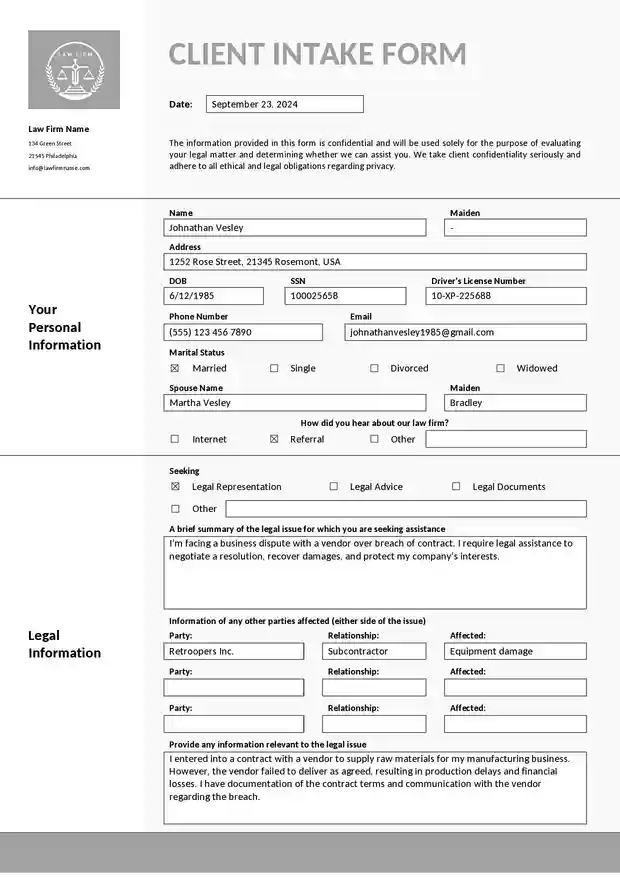
This template gathers details about a client’s legal issues, history, and what they hope to achieve. This helps lawyers plan the best way to assist their clients.
Facial Treatment Intake Form Examples
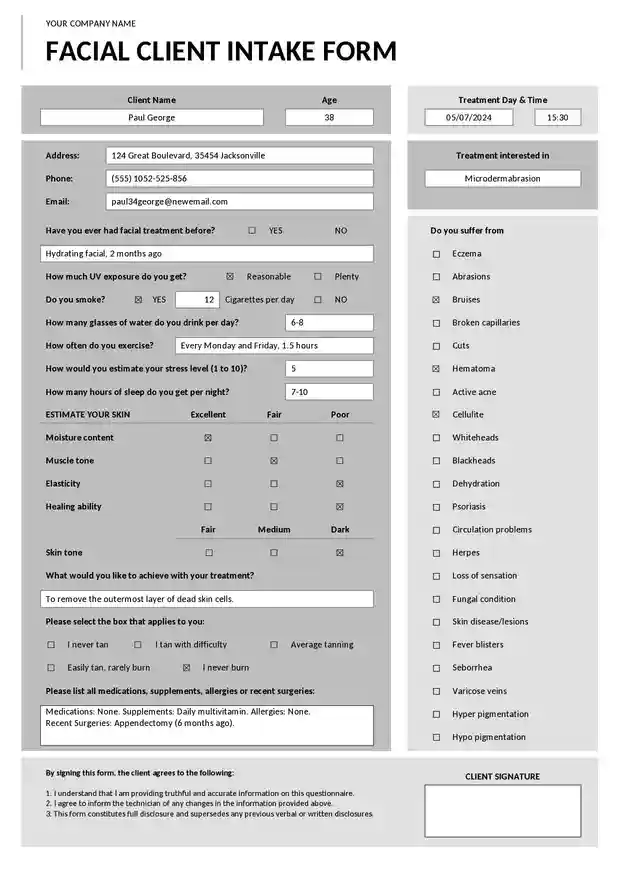
This form collects details about a client’s skin type, concerns, and allergies. This helps estheticians provide customized facial treatments.
Tax Preparation Intake Form Examples
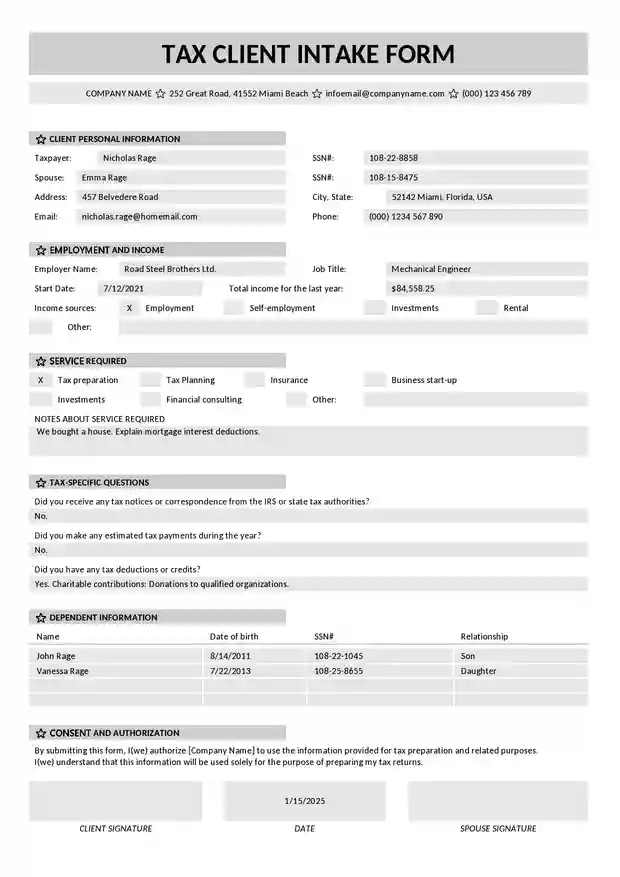
This template gathers information about a client’s financial situation, income, and tax history. This helps tax professionals prepare accurate tax returns.
Marketing Client Intake Form Examples
This form collects information about a client’s business, marketing goals, target audience, and budget. It helps marketers create effective strategies.
Hair Salon Client Form Examples
This form collects information about a client’s hair care routine, preferences, and any concerns they have. This helps stylists provide the best care.
Professional Tattoo Client Intake Form
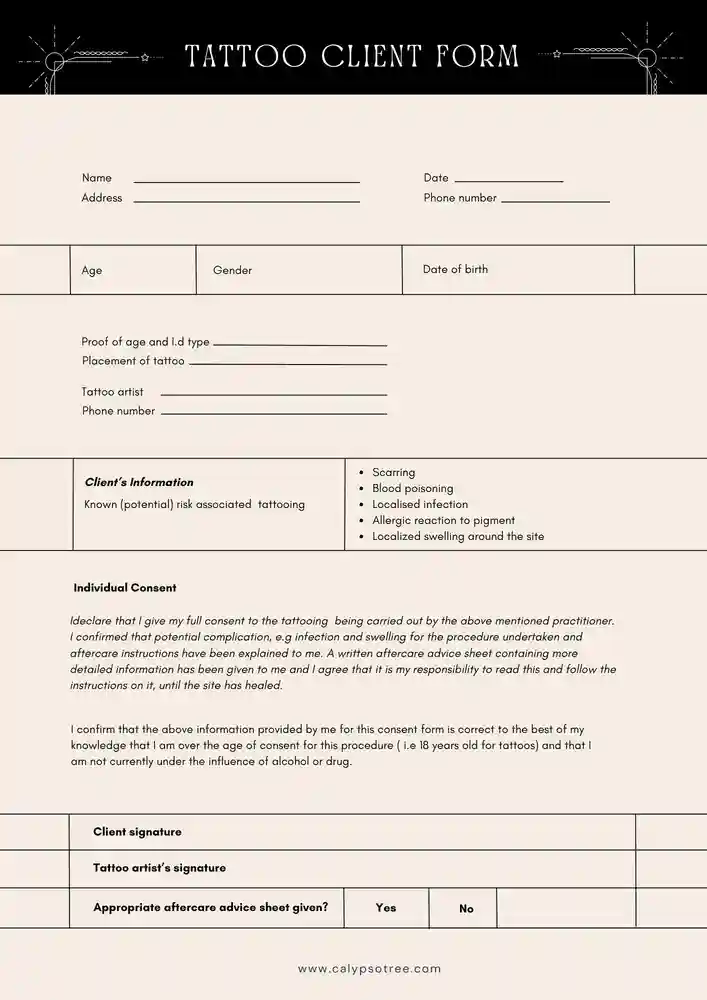
Digital vs. Paper Forms
In today’s digital age, it’s important to consider whether to use digital or paper forms. Here are some points to help you decide:
Digital Forms
Digital forms are online forms that clients can fill out using a computer, tablet, or smartphone. They offer many advantages:
- Easy to Fill Out: Clients can complete digital forms quickly using their devices.
- Easy to Store: Digital forms can be saved on a computer or cloud storage, making them easy to organize and find later.
- Access from Anywhere: Both the business and the client can access the forms from anywhere with an internet connection.
- Quick Updates: If any information needs to be changed, it can be updated instantly without needing to print a new form.
- Environmentally Friendly: Using digital forms saves paper, which is better for the environment.
Paper Forms
Paper forms are printed documents that clients fill out by hand. They can also be useful in certain situations:
- No Digital Access Needed: Paper forms are helpful when there is no internet or computer available.
- Client Preference: Some clients may feel more comfortable using paper forms, especially those who are not familiar with technology.
- Tangible Records: Paper forms provide a physical copy of the information, which some people prefer for keeping records.
Common Mistakes to Avoid
When creating and using client intake forms, it’s important to avoid these common mistakes:
- Making the Form Too Long: Keep the form concise to ensure clients complete it.
- Using Complicated Language: Use simple language that is easy for everyone to understand.
- Not Updating the Form: Regularly review and update the form to make sure it stays relevant.
- Ignoring Client Feedback: Listen to client feedback and adjust the form as needed to improve their experience.
- Not Explaining the Purpose: Make sure clients understand why you are asking for each piece of information.
Types of Client Intake Forms
There are different types of client intake forms based on what the business needs. Let’s look at some common examples:
General Client Intake Form Examples
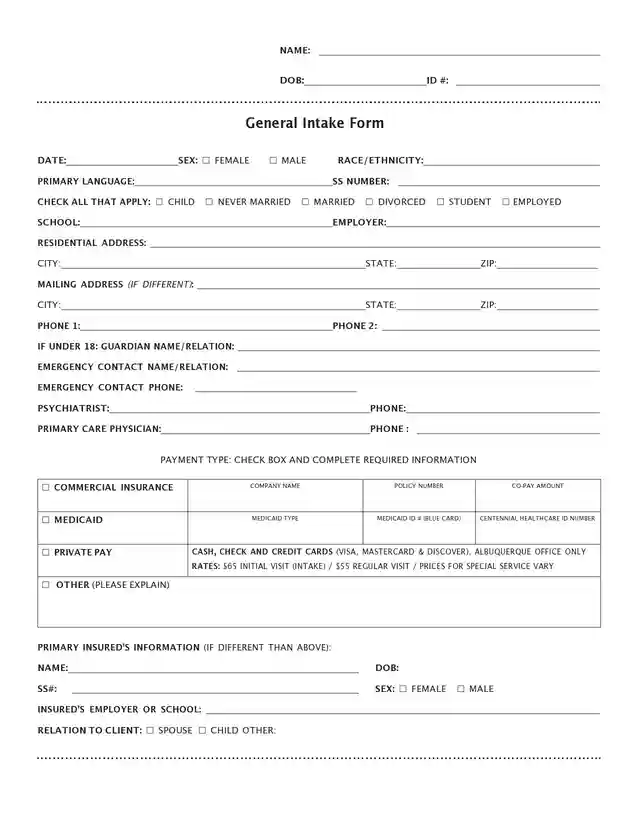
Many types of businesses use this Form. It helps gather basic information about new clients. This form usually asks for the following:
- Name: The client’s full name.
- Contact Details: Phone number, email address, and home address.
- Services Needed: What the client is looking for help with.
- Preferred Contact Method: How the client prefers to be contacted (phone, email, etc.).
This form is simple and can be used by many different kinds of businesses, like fitness trainers, hairstylists, or tutors.
Legal Client Intake Form Examples
Lawyers and law firms use this Form. It collects details about a client’s legal issues. This form might include:
- Client’s Personal Information: Name, contact details, and any relevant identification numbers.
- Case Details: Information about the legal issue, such as dates, involved parties, and a brief description of the problem.
- Legal History: Any previous legal issues or cases the client has been involved in.
- Desired Outcome: What the client hopes to achieve by hiring a lawyer.
This form helps lawyers understand the legal issues quickly and plan the best way to assist their clients.
Medical Client Intake Form Examples
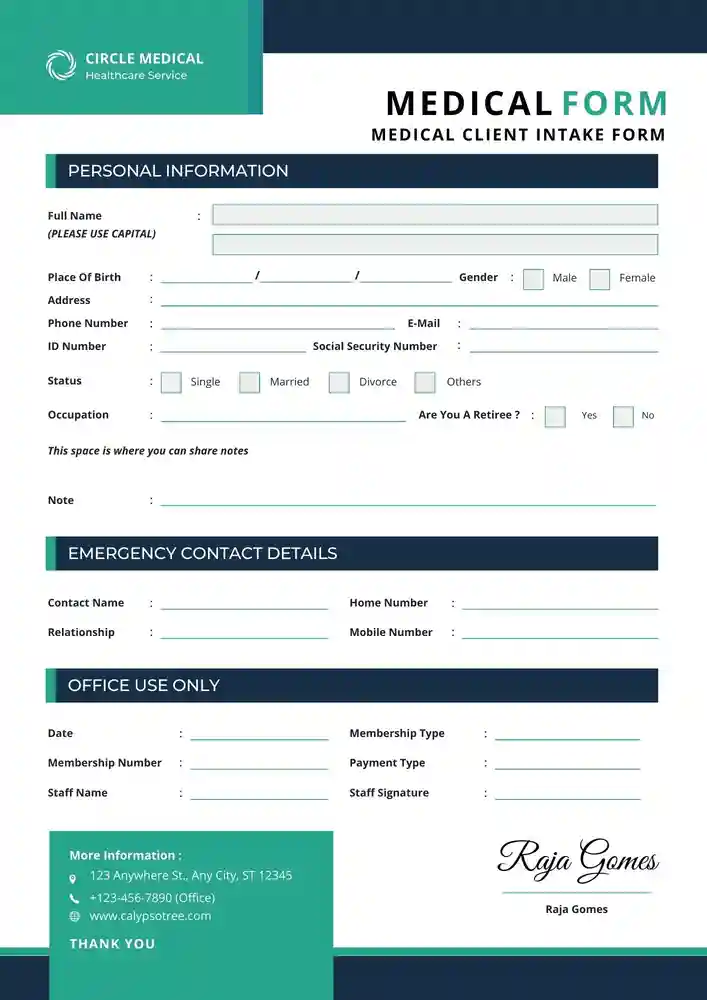
Doctors and healthcare providers use this Form. It helps gather health history and current health concerns. This form usually includes:
- Personal Information: Name, contact details, date of birth, and insurance information.
- Medical History: Past illnesses, surgeries, and ongoing medical conditions.
- Current Medications: Any medications the client is currently taking.
- Symptoms: Details about current health issues or symptoms the client is experiencing.
- Family Health History: Information about health conditions in the client’s family.
This form ensures doctors have a complete picture of a patient’s health before starting treatment.
Counseling Client Intake Form Examples
Therapists and counselors use this Form. It helps understand a client’s mental health needs. This form may ask for:
- Personal Information: Name, contact details, and emergency contact information.
- Reason for Counseling: What issues or problems is the client seeking help for?
- Mental Health History: Past mental health issues, previous therapy, and any medications taken.
- Current Situation: The client’s current life situation, stressors, and support system.
- Goals for Therapy: What the client hopes to achieve through counseling.
This form helps counselors create a personalized plan to support their clients’ mental health.
Consulting Client Intake Form Examples
Business consultants use this Form. It helps learn about a client’s business challenges and goals. This form typically includes:
- Business Information: Name of the business, industry, and contact details.
- Current Challenges: Problems or challenges the business is facing.
- Goals: What the business hopes to achieve with the consultant’s help.
- Previous Efforts: Any past attempts to solve the issues.
- Budget and Timeline: The available budget and desired timeframe for achieving the goals.
This form allows consultants to understand the client’s business situation and develop effective strategies.
How to Use the Information Collected
Once you have collected the information from your client intake form, here’s how to use it effectively:
- Analyze the Data: Review the information to understand the client’s needs and preferences.
- Plan Your Strategy: Use the data to create a tailored plan or strategy for the client.
- Communicate Clearly: Share your plan with the client and make sure they understand how you will proceed.
- Track Progress: Use the initial information as a baseline to track progress and make adjustments as needed.
- Build Relationships: Use the insights gained to build a stronger, more personalized relationship with your client.
How to Integrate Intake Forms into Your Workflow
Integration Steps:
- Train Your Staff: Make sure everyone knows how to use and handle the forms.
- Automate Where Possible: Use digital tools to send out and collect the forms.
- Monitor and Review: Regularly check completed forms to ensure they are filled out correctly.
- Follow-up: Use the information collected to improve client care.
Using Technology with Client Intake Forms
Technology Tips:
- Electronic Health Records (EHR) Systems: Connect forms to EHR for easy access.
- Mobile Apps: Use apps so patients can fill out forms on their phones or tablets.
- Secure Data Storage: Keep all digital forms secure to protect client information.
Client Privacy and Confidentiality
Privacy Tips:
- Secure Data Handling: Use safe methods to handle and store data.
- Limit Access: Only let authorized staff see client information.
- Compliance with Regulations: Follow privacy laws like HIPAA to keep client data safe.
Client Intake Form Best Practices
Best Practices:
- Clarity and Simplicity: Keep questions simple and easy to understand.
- Consistency: Use the same form for all patients to keep things uniform.
- Client-Friendly Language: Avoid using medical terms that might confuse patients.
- Accessibility: Make sure forms are easy to use for all patients, including those with disabilities.
Tips for Effective Communication with Patients
Communication Tips:
- Explain the Purpose: Tell patients why the form is important and how it helps them.
- Provide Clear Instructions: Make sure patients know how to fill out the form.
- Offer Assistance: Be ready to help patients with any questions.
- Follow-up: Confirm that you received the form and check any unclear answers.
Client Feedback on Intake Forms
Feedback Tips:
- Ask for Feedback: Regularly ask patients what they think about the form.
- Make Improvements: Use their feedback to improve the form.
- Keep It Anonymous: Let patients give feedback without putting their names on it to get honest responses.
Using client intake form examples can greatly benefit your healthcare practice. It makes gathering client information easy and efficient. This leads to better client care and satisfaction. Start using the intake form template today to improve your practice and help your patients better.

The content creator team at calipsotree.com is dedicated to making topics accessible to everyone, with over 9 years of experience in writing and breaking down complex concepts into easy-to-understand articles that answer readers’ financial questions.







